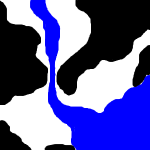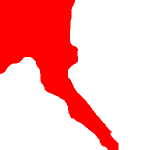GreyKnight asked for some sample tiles that show ‘nonlinear features’, so I’ve done up three tiles.
Sample Cave Tiles
I decided to do cave tiles because it was quick and easy (draw some squiggles, floodfill them, and call it done). Drawing with a mouse sucks.
Tile 1: Simple Cave
This is a very simple tile containing a cave with three entrances (NW, EN, SE). No special features, but the cave walls in the NE, ES, SW, WS, and WN sides can be considered ‘nonlinear features’ by the definitions of the previous post because the cover the entire section.
Tile 2: Water Caves
This is a slightly more complex tile. There are several linear connectors (river in the NW, tunnels in the EN and WS), and a lake covering the ES and SE sections. Again, the stone of the caves in the NE and WN sections can be considered nonlinear features as well.
Tile 3: Lava Lake
This may be the simplest tile of the three. This might be found in a large cave, there is a lava lake in the NW and WN sections, a stream of lava running to the southeast, and it travels out the SE connector. All the other connectors and sections (linear and nonlinear features) are empty space.
Addendums and Changes to the Last Article
I am assuming a few changes since the original article yesterday.
- Nonlinear features use the entire section they are found in. Alignment to the connectors was a decent idea at the time, but I had overlooked other layouts than conforming to a simple Cartesian grid (such as the offset grid, where each row is shifted half a tile to the side of the previous row). This would not work with nonlinear features that only go from the connector to the corner. Also, doing that would require specification of the content of the remaining section of that side (stone, empty space, etc.). It is simpler to treat each side as having two sections, each of which has a single nonlinear feature.
- I will change ‘linear’ and ‘nonlinear’ labels, there must be a better way to describe the two parts of each section (the bit that populates the connector, and the bit that covers the rest of that section). I am open to suggestions.
- The algorithm described yesterday was designed on assumptions from playing tile-placement games such as Carcassonne and looks for the best way to place tiles as they are drawn. Instead, an algorithm can be devised that will examine all available tiles, determine the viability of each, and then randomly select from the short list of viable tiles based on a weighted measure (such as quality of connection).
Closing Comments
I still believe the changes I have described will allow for richer geomorph-based maps. I know it will mean a lot of work coming up with enough tiles to make best use of these changes.



Was re-reading back over this and got to thinking: Microscope lets people design events and stitch them together into a setting time-wise. Geomorphs let people design areas and stitch them together space-wise. Regular RPG play has people designing characters and stitching them together socially. What if you smooshed them all together and completely distributed the idea of “game-master” out across all players?
y’know, I read Microscope last night and was pondering similar thoughts. I want to ponder this some more.
But right now, playing with my new tablet, so attention is not really here….
I came up with a slight modification of this idea. Designate an area of tiles as (for example) “huge cavern”. Tiles in the centre of this area are selected from a bunch of “cavern feature” tiles, which might just be open ground or might have features such as natural columns, carved statues, and so on.
Tiles around the outer edges are selected from a bunch of “boundary” tiles which have wide-open cavern ground on one or more edges and geomorph connectors on the other edges. The way the geomorph connector passages join to the cavern walls can be done in various ways (natural winding passages, well-carved entrances, maybe even a little vestibule).
You can also design the cavern area by placing one tile at a time, Carcassone-style, instead of predeclaring its extent.